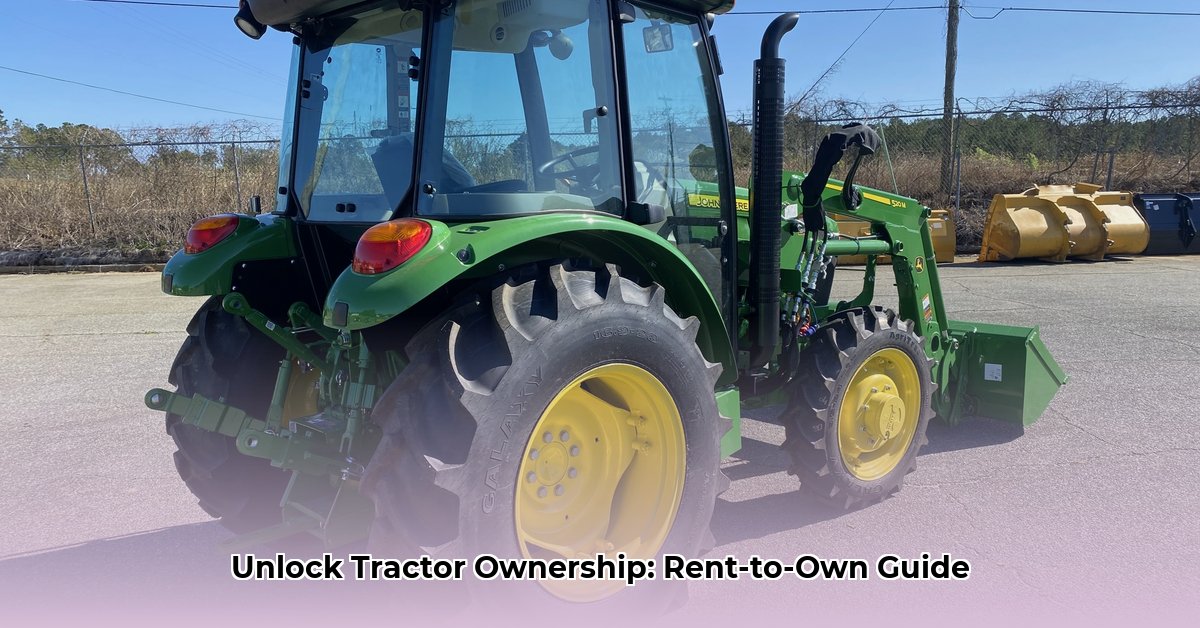
Buying a tractor is a significant investment for any construction business. Securing the right financing is crucial for success. This guide compares rent-to-own (RTO) and lease-to-own (LTO) options for tractors, providing a practical, step-by-step approach to choosing the best financing method for your specific needs. We’ll explain the key differences in costs, credit impact, and tax implications, ensuring you make an informed decision. For more in-depth information, check out this helpful guide: Tractor Financing Guide.
Understanding Rent-to-Own vs. Lease-to-Own Tractors
Rent-to-own and lease-to-own are alternative financing methods that allow you to acquire a tractor without a large upfront payment. However, they differ significantly in their structure and long-term costs.
Rent-to-own is essentially a long-term rental agreement with a built-in purchase option. You make monthly payments, and after a set period, you own the tractor. Think of it like a very long-term rental with ownership as the final payment.
Lease-to-own, on the other hand, is more similar to a traditional lease agreement. You pay a lower monthly payment, and at the end of the contract, you have the option to purchase the tractor for a pre-determined price. It's a lease with an option to buy.
Comparing Rent-to-Own and Lease-to-Own: A Detailed Analysis
The following table compares RTO and LTO, highlighting key differences to help you determine which option best fits your financial situation. Remember, specific terms vary depending on the dealer, tractor price, and agreement length.
| Feature | Rent-to-Own | Lease-to-Own |
|---|---|---|
| Upfront Costs | Typically lower; often requires a smaller deposit. | Usually higher; a larger down payment is common. |
| Monthly Payments | Generally higher than lease payments. | Typically lower monthly payments. |
| Total Cost of Ownership (TCO) | Often higher due to accumulated interest. | Potentially lower TCO, depending on terms. |
| Credit Impact | Minimal to moderate positive effect. | More substantial positive effect. |
| Tax Implications | Consult a tax professional. | Consult a tax professional. |
| Flexibility | More flexible; shorter contract lengths. | Less flexible; longer contract lengths. |
| Risk | Higher risk; total cost potentially higher. | Lower risk with consistent payments. |
Isn't it interesting how the seeming simplicity of each method hides a level of complexity in overall cost? Many think rent-to-own has lower upfront costs, but is that the whole picture?
Step-by-Step Guide to Choosing Your Tractor Financing
Choosing the right financing depends on a careful assessment of several factors. The following steps guide you through this decision-making process.
Step 1: Assess Your Needs and Budget:
- What type of work demands the tractor?
- What size and features are essential?
- What is your project timeline?
- What's your monthly payment capacity? What's your overall budget?
Step 2: Evaluate Your Credit:
Your credit score significantly impacts the interest rates and terms offered. A higher credit score generally secures better deals. Improving your credit score before applying can prove advantageous. Did you know that a higher credit score can mean potentially thousands of dollars saved over the life of the loan?
Step 3: Compare Multiple Offers:
Obtain quotes from at least three dealers and lenders. Carefully compare interest rates, fees, and contract terms. Transparency is vital; avoid lenders who obscure certain costs.
Step 4: Negotiate Terms:
Don't be afraid to negotiate. Dealers and lenders often have some flexibility. Leverage your credit rating and any offers from competing lenders to your advantage.
Step 5: Review the Contract Meticulously:
Before signing, review the contract thoroughly. Understand all clauses and conditions. If anything is unclear, seek clarification. Having a legal professional review complex contracts might be a wise investment.
Real-World Case Studies
(Space for case studies illustrating successful RTO and LTO implementations by contractors. Include a description of the scenario and the ultimate outcome for each contractor).
Conclusion: Making the Informed Decision
Choosing between rent-to-own and lease-to-own hinges on your specific needs and financial circumstances. Rent-to-own offers immediate access and flexibility, while lease-to-own could offer long-term cost savings, depending the terms. Careful planning, thorough comparison shopping, and a clear understanding of the contract terms are crucial for choosing the best financing suited to your business. Remember, consulting a financial advisor is always recommended before making such a substantial purchase.